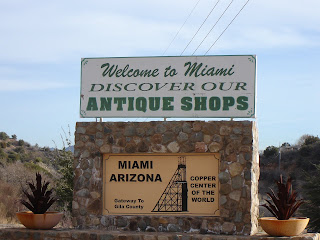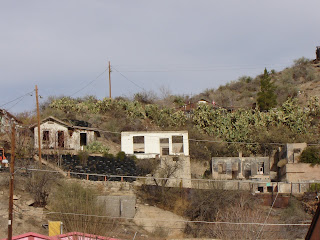Sunday, January 30, 2011
Rt. 60 - Arizona Mining Towns
A couple weekends ago, I headed east out of Phoenix on Rt. 60 towards the cities of Miami and Globe. Both of them are old mining towns in different states of repair. Globe, maybe due to its location at the crossroads of 3 highways, was in much better condition than Miami, which is a few miles west of Globe.
Miami, AZ - Two words: Beat Up. It was Sunday morning and there was little to no activity that I saw. The downtown area was in various states of disrepair with many boarded up and vacant buildings. There were a fair amount of antiques shops, but all were closed. It was kind of eerie.
Globe, AZ - This town was in much better condition with more activity. Although, being Sunday, a lot of places downtown were closed.
Subscribe to:
Post Comments (Atom)







































3 comments:
Love the "Hippies use backdoor".
That's a classic.
About the crucecitas:
Several times a day, Ruben C. Licano swings by the roadside shrine he built outside Miami, Arizona. As cars and trucks whiz by, he makes sure that candles are a safe distance from the snapshots, notes, and artificial flowers that bedeck the altar, and at the 3-foot-tall statue of the Virgin Mary is still in place. He also prays. Licano erected the shrine in 1977 with the help of a friend to fulfill a vow. "When I was in the Army in Korea, I promised the Virgin Mary that if I returned to Arizona alive, I would build a shrine," he says. "It took me a while, but I did it."
Prevailing over fires, vandals, thieves, sleeping transients, and even a prowling puma, Licano has kept the shrine open to anyone in need of spiritual comfort. Made of river rock and topped with a rebar cross, the shrine's walls and roof partially enclose a small altar that passersby have filled with personal mementos of loved ones and written pleas for everything from getting good grades to better health to world peace. Licano's roadside shrine is one of dozens that dot the desert landscape of southern Arizona. These public shrines, also called capillitas or grutas, have become Southwestern cultural icons. Part folk art and part pure expression of faith, they have evolved from the Spanish-Catholic traditions brought to the New World by early missionaries and settlers. Arizona's are different from the sometimes elaborate roadside crosses, also called crucecitas or descansos, that are more prevalent in New Mexico and mark the sites of fatal auto accidents and similar tragedies. The Arizona Department of Transportation has an unofficial hands-off policy that respects the cultural tradition of roadside shrines, as long as they pose no safety hazards. When Licano's shrine became caught in the crosshairs of a debate over religious symbols on public land, the department relinquished the land rights to a private owner, allowing the shrine to stay. --By Nora Burba Trulsson. Sunset Magazine.
Post a Comment